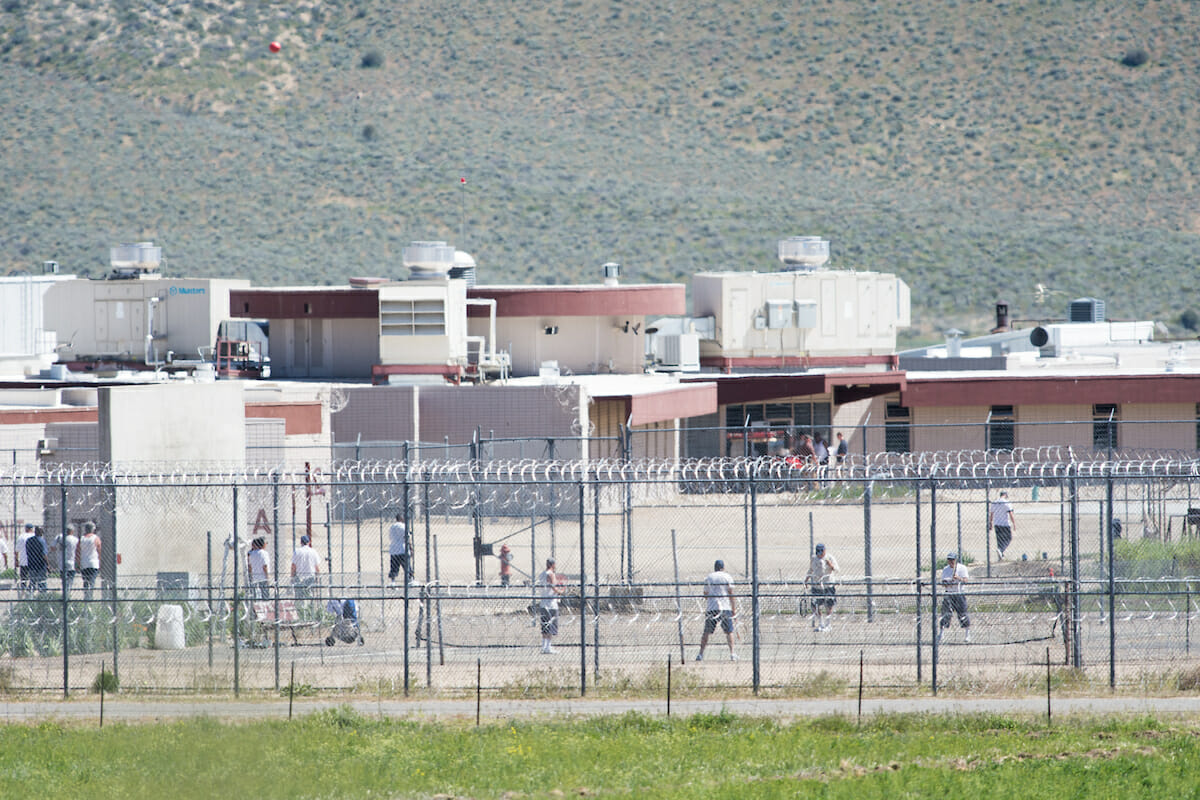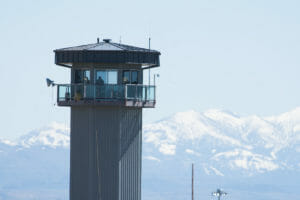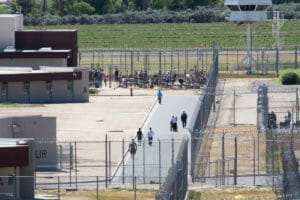Lawmakers keep tight rein on private prison use, even amid concerns that it leaves a bed shortage

Democratic lawmakers who are ideologically opposed to private prisons rejected a request to double the number of out-of-state beds the state will pay for in the next two years and are advancing a bill to eliminate their use in five years, in spite of concerns that the state’s prisons are already too crowded and need the relief.
Lawmakers approved funding this weekend for 200 private prison beds — the original request in Gov. Brian Sandoval’s budget — rather than the 400 in the Nevada Department of Corrections’ updated request, which was developed in consultation with Sandoval’s office and the Legislative Counsel Bureau’s Fiscal Analysis Division. Democrats cited the additional $8 million it would cost to double the private prison bed count.
“I'd love to give everybody who needs money across the board the money they need to do it, but we've got to pay for it,” Assembly Speaker Jason Frierson said at a subcommittee meeting last week where the recommendation received preliminary approval. “Maybe somebody will introduce a bill to raise taxes to fund some of this stuff and we'll consider it.”
The budget move came as Democratic lawmakers are also guiding a bill through the Legislature that would bar the state from outsourcing its core correctional work to private entities effective in 2022. That bill, AB303, is backed by Democratic Assemblywoman Daniele Monroe-Moreno, a former North Las Vegas corrections officer.
“The concern generally is if it's for-profit, it's less about the criminal justice system and rehabilitating people and more about a dollar,” Monroe-Moreno said in a recent interview.
Corrections officials said they’re planning to expand one of the state’s prisons over the next few years to accommodate 282 more inmates. But some Republicans worry that the short-term decision not to send a full 400 inmates out of state — which will leave a shortage of several hundred beds -- is “budgeting for a shortfall” and could could set the state up for a lawsuit.
“Clearly on the other side of the aisle a lot of people don't want to send any prisoners out of state,” said Republican Sen. Pete Goicoechea. “I realize it creates a hardship, but again, I'm very concerned that we might well run into problems with over-housing and get sued and then that $12 million becomes pretty insignificant.”
The concept

Monroe-Moreno originally wanted to ban Nevada’s use of private prisons immediately, but decided against it when hearing that the prisons would have to compensate for the resulting crowding by using “boats” — plastic frames with mattresses that function as makeshift beds.
"I had to work under those conditions in the city of North Las Vegas and I know firsthand that that's not safe for the employees," she said in a hearing for her bill on Monday.
Her bill allows for private prison contracts until a few other renovation projects are finished, including a unit at Southern Desert Correctional Center that’s been deemed unsafe. Two hundred inmates living there will have to be relocated while the construction project takes place.
"We shouldn't have anyone in there as of today,” Nevada Department of Corrections Director James Dzurenda said on Monday. “Public Works is saying it's too dangerous to keep offenders in there based upon the structure of the facility."
The bill also requires that inmates who aren’t originally from Nevada are sent away before Nevada residents, and requires that the private prisons offer videoconferencing to allow them visitation with their families.
Although Democratic Assemblywoman Maggie Carlton wanted assurances from the prisons chief that the inmates sent out of state would eventually return and their places in-state wouldn’t simply be backfilled with more offenders, he made no promises.
"That would be my hope as well,” Dzurenda said. “However, we have to look at what the future holds with the amount of inmates still coming in and the amount of inmates leaving our door. If that continues the way it is, we're still going to be facing the overcrowding in the future.”
Calculating prison capacity

When measuring prison capacity, the state uses the figure of 100 percent to indicate one inmate per cell. When every other cell is double-bunked, the state considers the capacity to be 150 percent.
A prison that’s at 168 percent of capacity — meaning more than every other cell is double-bunked — is considered to be at the “emergency threshold.” Working above 168 percent “could potentially put a strain on the physical components of the facility, and have the potential to create unsafe conditions for staff and inmates due to operating over emergency capacity,” according to the Fiscal Analysis Division.
The state is operating at 183 percent capacity, which is well above the emergency threshold of 168 percent.
There are 8,442 male cells or dorms across all correctional institutions in Nevada, which amounts to 11,941 available beds if each institution was operated at the recommended 168 percent capacity. When the state increases its double-bunking and adds in 412 “overflow beds” that are in day rooms or other non-traditional housing areas, there’s room for 12,799 inmates.
“The capacity is different than the number of inmates that are in beds,” Frierson said. “Everybody has a bed. That's not an issue. But they have to be flexible.”
Population projections provided in February by JFA Associates indicated the state would have 12,711 inmates in the upcoming fiscal year and 12,929 the year after that.
If the 412 overflow beds — and the ones in the unit that will be temporarily closed — are removed from circulation, the state would be short 324 beds in fiscal year 2018 and 754 in fiscal year 2019 relative to the emergency capacity threshold.
If initiatives from the Division of Parole and Probation to move inmates out of prison are successful — including day reporting centers, a pilot re-entry program and the expansion of the residential confinement — the state believes the inmate population would be reduced by 131 in fiscal year 2018 and 375 in fiscal year 2019.
But there would still be an average bed shortage of 193 beds in fiscal year 2018 and 379 beds in fiscal year 2019.
“Based on the capacity analysis and revised inmate population projections, it does appear that transferring only 200 inmates out of state would be insufficient to address the NDOC’s capacity issues,” officials with the Fiscal Analysis Division wrote about the situation.
A budget committee gave final approval on Saturday to spending $12.4 million over the biennium to move 200 inmates out of state, instead of moving 400 at a cost of $21 million.
The Nevada Department of Corrections provided the following statement Tuesday on the decision:
"The legislature provided funding for 200 inmates to be housed in contracted facilities out of state and acknowledged the projected need of additional housing. They also will provide contingency funds to the Interim Finance Committee that can be accessed by agencies, if needed. The NDOC will continue to support the State Parole Board and the Division of Parole and Probation in their reintegration efforts to successfully house inmates outside the prison walls."
Republican Sen. Ben Kieckhefer raised concerns about approving the lower amount even knowing there would be a bed shortage, saying that if prisons officials realized in the interim that they needed more space, it could blow the Interim Finance Committee’s budget. But he ended up voting to approve the pared-back private prison request.
“We've over the past few cycles had more inmates than we were projecting. So if that trend continues, our deficit is going to actually grow rather than shrink,” he said afterward. But, “I'm not one that tries to find ways to vote against things. It was the work of the subcommittee, I didn't serve on that subcommittee, my concerns I think are valid and stand. But I wasn't going to start trying to blow up budget closings.”
Feature photo: Inmates in the yard at the Northern Nevada Correctional Center in Carson City on May 19, 2017. Photo by David Calvert.
This story was updated at 10 a.m. on May 23, 2017 to add a statement from the Nevada Department of Corrections.
